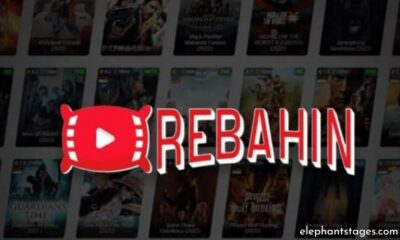Education
Must-Have Strategies for a Successful Book Launch

Key Takeaways
- Create a buzz before the book hits the shelves to ignite reader interest.
- Use the power of social media to reach and engage with a broader audience.
- Gain the support of influencers and bloggers to increase credibility and outreach.
- Collect and showcase genuine reviews to build trust among potential readers.
- Connect with the audience through well-organized virtual events.
- Maximize email marketing for personalized and impactful communication.
- Network and promote at literary events to tap into communities of book lovers.
- Invest in paid advertising for targeted exposure.
- Develop partnerships with bookstores to enhance physical presence.
- Enrich the reading experience with supplementary content and offers.
Building Anticipation Before the Big Reveal
In the story-enthusiast’s universe, where anticipation escalates with each page flip, executing a book launch becomes akin to directing a blockbuster premiere in a tale similar to how J.D Barker’s new book captivated TikTok audiences, a successful launch anchors on nuanced, audience-centric strategies that echo across the literary cosmos. The art of storytelling begins long before the official release—as authors, we weave a narrative tapestry that extends beyond the confines of our books’ covers. Teasers, intriguing polls, and interactive content play roles in this intro, whetting the public’s appetite for the debut. It’s about constructing a universe parallel to the narrative itself, compelling potential readers to yearn for the day they can delve into your creative reality.
Capitalizing on Social Media Momentum
With billions scrolling through social feeds daily, platforms like Twitter and Instagram become arenas where authors vie for attention—not through combative contention but through compelling cooperation with their audiences. These outlets offer a canvas for creative promotional campaigns that can tell a story within a story, one post at a time. The use of targeted ads, the power of algorithmic reach, and the dynamics of social sharing merge to form a wave of digital buzz that carries your book’s name from the screen to the shelf.
Engaging with Influencers and Bloggers
Allying with literary influencers and bloggers means enlisting the voices of those whom readers trust. A single share or recommendation from an admired personality becomes an invaluable asset—akin to a friend’s insistent urging to read what might become their favorite book. It’s a collaborative dance where relationship authenticity is blood to benefit the book and the influencer’s community.
Securing Reviews and Testimonials
Nothing speaks louder in the literary arena than the voices of those who have journeyed through your pages. Advanced review copies (ARCs) serve as heralds of your narrative, dispatched to critics and avid readers who help weave the early threads of discussion and praise. A well-placed review from a respected source can be as impactful as a personal recommendation—this is the power of words promoting words.
Organizing Virtual Events and Webinars
Virtual events are not a substitute for in-person encounters but a frontier in their own right—a venue for fostering intimacy despite distance, drawing in individuals for whom physical locales might be inaccessible. Revealing the inspirations behind your characters, conducting interactive writing workshops, or simply sharing the journey of your book’s creation can personify you as the author, generating a sense of camaraderie with readers worldwide.
Leveraging Email Marketing
Email marketing remains one of the most direct conduits to the reader’s mind. A well-composed email can feel like a whispered secret or a letter from an old friend, inviting readers to participate in something special. Intelligent segmentation and personalization ensure that messages resonate, whether a countdown to release day, an exclusive excerpt, or a personal story related to your book’s theme.
Exploring Literary Festivals and Book Fairs
At literary festivals and book fairs, the air is thick with the magic of storytelling. These events assemble authors, publishers, and book enthusiasts in celebratory communion. Your presence, whether for a signing, a reading, or a workshop, can carve your book’s name into the memories of those wandering among the aisles, thirsting for narrative experiences.
Utilizing Paid Advertising Capabilities
Even the most vibrant stories may remain hidden without a beacon to guide readers to their shores. Paid advertising is that beacon—a calibrated spotlight that can illuminate your book amid a sea of titles. Through keywords, demographics, and interests, platforms can help you place your book in the right hands—hands poised to turn the page.
Building Strong Retail Relationships
Just as every reader is a world unto themselves, so is every bookstore a universe of opportunity. Cultivating ties with independent local bookshops and national chains creates avenues for displays, signings, and promotions. These partnerships can be the cornerstone of a physical launch, allowing you to anchor your book firmly in the tactile world.
Offering Value Beyond the Book
Extra content and physical items can improve the reading experience. A well-planned launch with a personal touch and a good understanding of the story can make a book stand out. Celebrated and shared stories are intentionally created through a carefully crafted launch. By combining these methods, authors can create a compelling invitation to readers.
Education
Scratch and Language Learning: How to increase your vocabulary in scratch

Learning a new language is always fun activity but can also sometimes feel like a challenging task for kids, but with tools like Scratch, the process can become much more engaging and fun. Block based Coding aka Scratch’, is a platform that allows kids to create interactive projects like games, stories, and animations all while practicing language skills.
By the end of this article, you will understand how to successfully use Scratch as a tool to learn language. Kids, parents, educators and anyone can use Scratch to practice vocabulary and language skills through simple coding exercises and fun projects.
Why Use Scratch for Language Learning?
- By integrating vocabulary practice into Scratch projects, kids can learn new words in a real time and creative environment. Instead of relying on traditional methods of learning, they get to engage with words in interactive and meaningful ways, which in turn increases retention and understanding. Scratch allows kids to use their own imagination while practicing essential language skills.
- Parents and educators as well can use Scratch as a tool to make language learning a more playful and less intimidating experience where it is emphasised more on helping kids build a strong foundation in both coding and language skills.
Easy Ways to Practise Vocabulary with Scratch
1. Interactive Flashcards
For starters, the easiest projects to start with, is creating interactive flashcards in Scratch. Kids can create their own cards that display a picture of an object (like say an animal or a fruit), and when they click on it it changes and the name of the object appears or is spoken aloud in the target language.
How to Create It:
- Use different sprites representing vocabulary words.
- Use the block that says “say for 2 seconds” to make the sprite actually “say” the word in the target language.
- Add sounds by recording your own voice or either you can use Scratch’s ‘Text-to-Speech Extension’ to have the word be spoken aloud.
Benefits:
- Here kids can reinforce their understanding of vocabulary through both visual and auditory clues.
- Interactive flashcards are way more engaging than traditional paper flashcards.
2. Vocabulary Matching Game
A matching game is another fun way to practice vocabulary. In this project, kids can create a game where they match words in the target language to pictures or their meanings in the native language.
How to Create It:
- Create about 2 pairs of sprites: One with the word (anything of your choice) and the other one with an image or translation.
- Use the block “if [the specific word] is clicked” to check if the player selects the right match.
- Add more variables to keep track of the score, and use the block “broadcast [message]” to provide feedback pop ups like “Correct!” or “Try again.”
Benefits:
- This game encourages the skill of problem-solving and reinforces vocabulary.
- The fun part adds an element of enjoyment and competition to vocabulary practice.
3. Interactive Stories
Creating interactive stories in Scratch allows kids to use vocabulary in context. They can build a simple story where characters talk and interact with each other using words and phrases from the target language. Kids can practice writing dialogues and narrating actions, making the vocabulary more meaningful.
How to Create It:
- Choose characters (sprites) to represent the story’s cast.
- Use the “say [text]” and “wait [time] seconds” blocks to write dialogues in the target language.
- Include background changes (stages) to represent different scenes in the story.
Benefits:
- Storytelling is a great way that allows the user to develop contextual learning, where kids can see how words are used in sentences.
- It improves both vocabulary and grammatical understanding.
4. Quiz Game
A vocabulary quiz game in Scratch is a great way to test knowledge while keeping it fun. Kids can answer multiple-choice questions or type in the correct word for a given picture or translation.
How to Create It:
- Use the “ask [question] and wait” block to prompt the player with a question.
- Add the “if [answer] = [correct word]” block to check the answer and give feedback.
- Use a variable to track the player’s score and show their progress through the quiz.
Benefits:
- Quizzes encourage kids to recall vocabulary actively, improving retention.
- By creating the quiz themselves, kids are reinforcing their own learning process.
5. Language-Based Animations
Animations can help reinforce vocabulary by having characters act out actions described in the target language. For example, a character could be programmed to “jump,” “run,” or “eat,” depending on the command given in the foreign language.
How to Create It:
- Choose a sprite and use movement blocks like “move [x] steps” or “glide to [position]”.
- Pair these actions with spoken or written commands in the target language, such as “say [jump] for 2 seconds”.
- Add a catchy background music or sound effects for more engagement.
Benefits:
- Kids get to see vocabulary in action, and especially verbs in turn helping them understand the meaning more clearly.
- Animation projects encourage creativity and help kids learn words in an active way.
Conclusion
Ranging from flashcards to games and from stories to animations, the kids can apply their vocabulary knowledge in exciting and practical ways. The combination of coding and language makes learning fun, and effective.
Jump right on to Codingal’s coding courses for kids where kids and teens learn to adapt to the digital world of coding through simple and fun learning experiences!
Encourage learning everywhere you go and have fun with your coding journey! At Codingal, we’re here to support you in every step of the way. Happy coding!
Education
The Ultimate Guide to ESAT Preparation Courses: Everything You Need to Know

The ESAT, or Engineering Selection Aptitude Test, is definitely a challenge, but preparing effectively can turn it into an opportunity to shine. You need to think about developing solid study habits and considering various prep options.
The ESAT preparation course used to be well-rounded. They dive into the main subject areas of the ESAT—usually including maths, logical reasoning, and sometimes physics. These courses often leverage past papers and practice exams to familiarise you with the format and types of questions you’ll encounter, which is super helpful for getting into the test mindset.
Maths Calculation Techniques
A good prep course will cover key maths concepts, from algebra to calculus, ensuring you have the quantitative skills needed for the exam. Sharpening these skills with specific calculation techniques can save you time and nerves when the clock is ticking.
Many ESAT exams are scheduled around winter, so getting a jump start on your prep can give you a nice runway to mastery.
Effective Study Habits for the ESAT
- Create a Visual Schedule: Keep a calendar in clear sight to track not just major dates but also your study goals. Include milestones and check-ins to keep your prep on track.
- Balanced Study Sessions: Mix intense study sessions with lighter, exploratory learning. Dive deep into challenging topics but balance it out with some engaging engineering reads to spark inspiration.
- Active Learning: Engage with the material actively. Solve plenty of practice problems and work through sample tests to familiarise yourself with the exam format and timing.
- Consistent Review: Instead of cramming, review material regularly. Spaced repetition helps solidify your understanding and recall of key concepts.
- Peer Discussions: Connect with fellow students for group study sessions. Sharing insights and teaching each other can clarify concepts and reveal different problem-solving approaches.
- Mindfulness and Breaks: Remember to incorporate short breaks in your study plan. During those breaks, practice mindfulness or light exercises to reset and refresh your brain.
Cool Calculation Techniques
Japanese Multiplication (a.k.a. Lattice Multiplication, or Line Method)
This method is part of traditional Japanese maths, influenced by visual and spatial learning styles.
It uses a lattice grid where lines represent the digits to be multiplied, and intersections form smaller units of the final number. Visually elegant, it emphasises clarity and organisation. No carryovers required mentally – everything’s visually represented.
- Quick Overview: Draw lines to represent each digit of the numbers being multiplied. Intersecting points represent parts of the final product.
Visual and intuitive, especially for those who think better with images.
Example:
To multiply 34 by 12:
Draw 3 parallel horizontal lines (for 3) plus 4 parallel lines beneath them (for 4).
Draw 1 set of vertical lines intersecting the horizontal lines (for 1) and another set (for 2) next to the first.
Count the intersections and add them accordingly.
Vedic Mathematics
Vedic Mathematics hails from ancient India, with its principles found in the Vedas, ancient Hindu scriptures. It comprises various handy techniques for mental calculations, making math faster and, dare I say, more fun!
Nikhilam Sutra (All from 9 and last from 10): Great for subtracting numbers from a base like 100 or 1000.
Using the Vertically and Crosswise method for multiplication:
Suppose you want to multiply 32 by 43.
Step 1: Multiply the units place numbers together: (2 x 3 = 6).
Step 2: Cross-multiply and add: ( (3 x 3) + (4 x 2) = 9 + 8 = 17 ). Keep the 7 and carry over 1.
Step 3: Multiply the tens place numbers together and add the carry over: (3 x 4 = 12). Adding the carry over (12 + 1 = 13).
So, 32 x 43 = 1376. Voilà! Speedy, efficient, and kind of impressive at parties.
Trachtenberg Speed System
Developed by Jakob Trachtenberg, a Ukrainian engineer, during his time as a prisoner in a Nazi concentration camp, seeking to use his time productively and to keep his mind sharp.
Trachtenberg’s system involves a series of methods that simplify arithmetic by breaking down operations into smaller, more manageable steps. This system uses rules to streamline calculations significantly.
Addition: Use complementary numbers to reduce carrying over in addition.
Multiplication: Divides complex multiplication into simple steps.
Multiplying by 11:
Write down the first digit.
Add each pair of digits and write the result.
Write down the last digit.
Example: 352 x 11:
Step 1: Write 3 (first digit).
Step 2: Add 3 + 5 = 8.
Step 3: Add 5 + 2 = 7.
Step 4: Write 2 (last digit).
Result: 3,872.
Different rules exist for other multiplications. For example, multiplying by 12, 13, etc., each follows specific, easy-to-grasp rules that streamline larger calculations by reducing steps needed.
Addition and Subtraction
Adding quickly by simplifying each step.
Rule: Adding small numbers to larger ones by visual snapshot strategies and minimising extra steps like carryovers through complementary addition.
Example:
567 + 487:
Start from the right: 7 + 7 = 14, write 4, carry 1.
6 + 8 + 1 = 15, write 5, carry 1.
5 + 4 + 1 = 10, write 0, carry 1.
Bring down final 1 for 1054.
Memorization Techniques for Formulas and Concepts
- Chunking: Break formulas into smaller parts. For example, break the quadratic formula into chunks like “b squared,” “minus four,” etc.
- Mnemonics: Create catchy phrases to remember sequences. For trigonometry, use “SOHCAHTOA” for Sine = Opposite/Hypotenuse, Cosine = Adjacent/Hypotenuse, Tangent = Opposite/Adjacent.
- Visualisation: Draw diagrams or mind maps. Visual connections stick better than plain text.
- Spaced Repetition: Use apps like Anki for flashcards that emphasise regular review. Repetition over increasing intervals boosts retention.
- Memory Palace: Assign different parts of a formula or concept to locations in a mental “palace.” Wandering through your palace triggers memory recall. Imagine walking through a familiar place (your home, perhaps) and visually placing parts of a formula in different locations. When you need the formula, mentally revisit these places and retrieve the elements.
Practice x 3
Chessboard Practice
Turn a blank chess board into a practice grid. Fill it with problems and solve them as you move across it like a knight.
Think of a chessboard with its 8×8 grid. Here’s how you can turn it into a maths playground:
- Start with a Blank Board: Draw an 8×8 grid on a piece of paper, mimicking a chessboard.
- Fill the Squares: Write different maths problems in each of the 64 squares. These can range from simple arithmetic to complex algebra problems, depending on your level.
- Move Like a Chess Piece: Choose a chess piece and move accordingly. For example, if you move like a knight, tackle the problems that the knight’s L-shaped movement lands on. Solve the problem, then move to the next square following the knight’s moves.
This makes practice dynamic and varied, breaking up the monotony and testing different areas of your maths skills randomly.
Storytelling
Turn formulas into little stories. For example, for ( f(x) = ax^2 + bx + c ), invent characters (a, b, c) that come together to create a plot ( y = f(x) ). While storytelling can be playful, it’s not everyone’s cup of tea. If remembering formulas directly works better for you, then stick to what’s effective!
In the world of maths, diverse techniques cater to varied learning styles. Choose what resonates with you, and keep exploring new methods.
YOU MAY ALSO LIKE: F02 Practice Test: Prep for Success
Education
F02 Practice Test: Prep for Success

Understanding the F02 Practice Test
Getting ready for the F02 certification? The practice test is key. It’s like a mini version of the real exam. It shows you what you know and what you need to work on.
What is the F02 Practice Test?
The F02 practice test is a detailed test that looks like the real exam. It lets you get used to the questions, how hard they are, and how much time you have. This practice is super helpful for feeling confident and ready.
Why is the F02 Practice Test Important?
The F02 practice test is very important for several reasons:
- It shows you what you know and what you don’t, so you can study better.
- It’s like the real exam, so you can learn to manage your time and handle the test.
- Doing the practice test often makes you feel more comfortable with the exam. This can help you do better on the real day.
Key Topics Covered in the F02 Practice Test
The F02 practice test checks your knowledge and skills in many F02 exam topics. It’s based on the F02 certification exam content. Knowing these topics helps you get ready for the F02 practice test subjects.
The test covers important parts of project management, such as:
- Project initiation and planning
- Risk assessment and mitigation strategies
- Regulatory compliance and industry standards
- Stakeholder management and communication
- Resource allocation and budgeting
- Project monitoring and control
- Closeout and evaluation processes
Effective Strategies for the F02 Practice Test Preparation
Getting ready for the F02 certification exam needs a smart plan. The F02 practice test is a key tool in your prep. By using good study methods and practicing with sample questions, you can improve your chances of passing the F02 exam.
Create a Study Plan
It’s important to make a study plan for the F02 practice test. First, check what you know and what you don’t. This helps you use your time and resources wisely. Make a detailed plan that includes both studying and practicing, covering all the exam’s key topics.
Practice with Sample Questions
Practicing with F02 sample questions helps improve your test skills and confidence. By trying different question types and levels, you get used to the exam’s style. Look at how you do on these questions to find areas to improve and adjust your study plan.
Remember, the F02 practice test is more than just memorizing. It’s about really understanding the concepts and using them right. Take a proactive, strategic approach to your exam prep. This will help you reach your certification goals.
F02 Practice Test Formats and Delivery
There are many ways to prepare for the F02 exam. Knowing the different practice test formats can help you find what works best for you. The F02 practice test comes in online and paper-based formats, each with its own benefits.
Online vs. Paper-Based Tests
F02 online practice tests are easy and flexible. You can take them on your device, like a laptop or phone. These tests often have interactive features, like videos and adaptive questions, to make learning fun.
F02 paper-based practice exams offer a traditional feel. They’re like the real exam, giving you a hands-on way to prepare. Some people prefer the feel of paper and pen for studying.
Choosing between online and paper-based tests depends on what you need. Think about what you prefer: ease of access, how you manage time, or interactive features. Pick what helps you prepare best.
Mastering Time Management for the F02 Practice Test
Effective time management is key for success on the F02 practice test and the real exam. Learning to pace yourself, allocate time well, and manage stress can boost your chances. This way, you can finish the test on time and get a good score.
Knowing the test format and question types is a big help. It lets you plan your time better. Also, practicing the F02 practice test under time pressure helps you get used to the exam’s pace.
- Make a F02 certification test-taking time tips plan: Set time limits for each test section. Stick to your plan to avoid spending too much time on one question.
- Keep your stress levels down. Stress can mess with your focus and time management. Use relaxation techniques like deep breathing to stay calm and focused.
- Practice managing your time actively. Check the time often during the test. If you’re spending too long on a question, move on. Keep a steady pace throughout.
Conclusion: Boost Your Confidence with the F02 Practice Test
Mastering the F02 practice test boosts your confidence and prepares you for the real exam. You’ll learn the test format, key topics, and how to prepare. This way, you’ll face the F02 exam with confidence and determination.
The F02 practice test offers many benefits. It helps you find your strengths and weaknesses. It also lets you create a study plan to fill any knowledge gaps. Plus, practicing with sample questions makes you feel more familiar and confident for the real exam.
Getting the F02 certification is a big step in your career. Preparing with the F02 practice test is a smart move. It helps you show your skills and get the recognition you deserve. Stay focused and let the F02 practice test guide you to success.
-

 Fashion10 months ago
Fashion10 months agoAttractive Beach Dresses: Elevate Your Look with These Ideas
-

 Home Improvement5 months ago
Home Improvement5 months agoEssential Drain Cleaning Tips for Brampton Residents
-

 Entertainment9 months ago
Entertainment9 months agoNetnaija: Your One-Stop Shop for Free Movies in Africa
-

 Pets9 months ago
Pets9 months agoPawsitively Perfect: The Types of Dog Harness Bundle for Your Furry Friend
-

 News9 months ago
News9 months agoWhat Are the Biggest Challenges in Marine Construction Projects in Australia?
-

 Health11 months ago
Health11 months agoUnderstanding Ftmç: Gender-Affirming Surgery
-

 Business10 months ago
Business10 months agoHow Professional Concrete Cleaning Wins Repeat Business
-

 Entertainment11 months ago
Entertainment11 months agoUnlocking Cinematic Pleasures: A Comprehensive Look at Rebahin, the Free Movie Streaming Haven
















